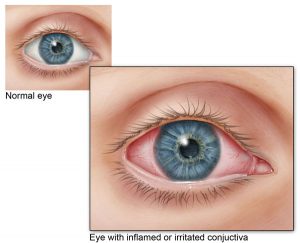 At one time or another, everyone is affected by red eyes. They happen when the tiny blood vessels in the white area of the eye, known as the sclera, become inflamed or “bloodshot.” But the reasons behind the red eyes can vary widely and that’s why it’s important to keep an eye on them and know when you should seek medical help.
At one time or another, everyone is affected by red eyes. They happen when the tiny blood vessels in the white area of the eye, known as the sclera, become inflamed or “bloodshot.” But the reasons behind the red eyes can vary widely and that’s why it’s important to keep an eye on them and know when you should seek medical help.
First, let’s take a look at what causes an eye to become inflamed; it’s usually because of an environmental issue, a lifestyle choice, or an underlying problem (and sometimes all three!). Here’s a quick chart to show the main factors and some examples of what causes them:
|
Environmental |
LifeStyle |
Underlying Problem |
|
Alcohol |
Autoimmune Disorder (Lupus, Rheumatoid Arthritis, etc.) |
|
|
Chemicals (chlorine, shampoo, etc.) |
Blepharitis (eyelid infection) |
|
|
Dry Air |
Conjunctivitis (an infection of the eye, also called pink eye) |
|
|
Pollution |
Lack of Sleep |
Diabetes (a hormone disease that can lead to vision loss) |
|
Smoke |
Dry Eye (decreased tear production) |
|
|
Episcleritis (inflammation, usually not painful) |
||
|
Glaucoma (a condition of increased pressure in the eye) |
||
|
Iritis (inflammation of the colored part of the eye) |
||
|
Keratitis (inflammation of the cornea) |
||
|
Scleritis (deep tissue inflammation, usually painful) |
||
|
Stye (bacterial infection of the eyelid) |
||
|
Subconjunctival hemorrhage (a blood spot that appears on the whites of the eyes) |
||
|
Uveitis (sudden onset, painful, infection of the middle-layer eye tissue) |
As you can see from this list (by no means exhaustive) there’s a range of minor issues on up to major ones that can cause red eyes to happen. When to see a doctor about them will largely depend on whether or not the eye/s clear up on their own in a day or two, or if you have other problems happening as well. An infection such as blepharitis (eyelid), stye, or conjunctivitis, will often be itchy, produce mucus or watery eyes that cause irritation along with red eyes and should be checked out by your eye care doctor (especially conjunctivitis as it is contagious). Of course, any injury to the eye will need immediate attention.
You should definitely see your eye care provider if your red eye comes on suddenly and you have blurry vision, unusual sensitivity to light, a headache, or any swelling in or around the eye. These additional symptoms could be indicators of an underlying infection or a condition such as diabetes, cancer, or an autoimmune disease. Your eye care provider will conduct a comprehensive eye exam and will be able to see if these types of underlying factors are the cause of the eye inflammation. They will direct you to the appropriate doctor for follow-up examinations if needed.

